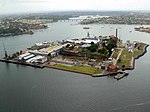Dawn Fraser Swimming Pool
Balmain, New South WalesNew South Wales State Heritage RegisterSwimming venues in AustraliaUse Australian English from June 2018

Dawn Fraser Swimming Pool is a heritage-listed swimming baths complex at Glassop Street, Balmain, Inner West Council, Sydney, New South Wales, Australia. It was built by 1882 by James Reynolds, with alterations when it was enlarged in 1924. It is also known as Elkington Park Baths, Balmain Baths, Corporation Baths, Dawn Fraser Baths and Whitehorse Point Baths. The property is owned by the Inner West Council. It was added to the New South Wales State Heritage Register on 23 June 2000.
Excerpt from the Wikipedia article Dawn Fraser Swimming Pool (License: CC BY-SA 3.0, Authors, Images).Dawn Fraser Swimming Pool
Fitzroy Avenue, Sydney Balmain
Geographical coordinates (GPS) Address Website External links Nearby Places Show on map
Geographical coordinates (GPS)
| Latitude | Longitude |
|---|---|
| N -33.8534 ° | E 151.1732 ° |
Address
Dawn Fraser Baths
Fitzroy Avenue
2041 Sydney, Balmain
New South Wales, Australia
Open on Google Maps









